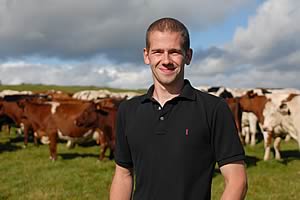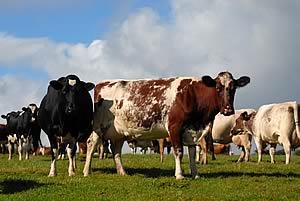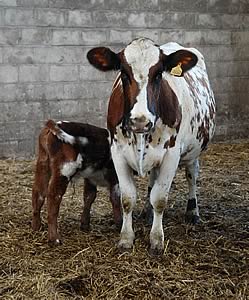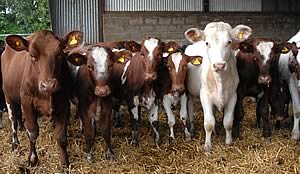 |
|||||||||
|
||||||||||||||||||||
|
|
Plentiful Benefits and Savings with Dairy Shorthorns While yields may not match those of Holsteins, there are plenty of other management benefits and savings with running Dairy Shorthorns, says young producer and enthusiastic convert to the traditional breed, Rob Kite.
At 22, Rob is in partnership with his father, Bob, running the 170-cow pedigree dairy herd at Coton Hall Farm, Milwich, Stafford. Keen to run a dairy herd, Rob left school in 2003 to help his father on the farm. He studied agriculture at Rodbaston College, followed by a dairy herd management course at Reaseheath College, Nantwich. While the farm, which runs to 168 acres of owned land with a further 150 acres rented, had never had a pedigree dairy herd, Rob’s interest in pedigree cattle began while at college. “It was in 2004 that my dad asked if I was interested in going to a Dairy Shorthorn society sale at Chelford and we bought the reserve champion Dunham Duchess Ann 48, which is still in the herd, and Winbrook Dairymaid 92,” said Rob, whose passion for coloured breeds comes from his late mum, Isobel. “We continued to attend the sales and add a few more Shorthorns to the herd, buying established family names “We bought our first Dairy Shorthorn bull in 2006 from David Winnington at Stafford and we used him heavily across the herd with his first calves born in the spring of 2007,” he added.
Faced with the choice of running the herd commercially or on pedigree lines, Rob decided to start registering the cattle in January 2008 under the Cotonhall prefix, at the same time starting monthly milk recording. Rob has also started classifiying cattle and the original stock bull, Rantonhall Rambo, is now classified EX90. A Rantonhall cow, bought in calf at Chelford, has classified VG 89 and her daughter is 84 pts as a heifer and dam to young bull Cotonhall Onyx. Now almost 50 per cent of the herd is registered Shorthorn and the aim is to have all cows in the herd with between 60 and 70 per cent Shorthorn blood but will keep the pure shorthorns pure. Previously the herd was mostly Holstein with the odd Jersey and Ayrshire. “We found the Holsteins weren’t lasting even though we thought we had bred some really good heifers,” said Rob. “I don’t blame the breed which is good for producing high volumes of milk - it’s probably because our system doesn’t suit them with us needing to have bigger cubicles and more forage. All the land is grass and suits the Shorthorns perfectly. “We calved the first daughters of Rambo in the spring of 2009 at two years old, we have been very pleased with them and have started using him over the herd again. The intention is to calve the heifers at around 26-27 months old to prevent them putting on too much condition. “The Shorthorn is a hardy breed and we are learning how to manage them as they can put body condition quickly at end of the lactation. “We were feeding the Holsteins with a lot more corn and concentrates and all these things add up. For the sake of ease of management we’re accepting that the Shorthorns are going to produce less milk but make up for it with better feet and legs, longevity, fertility and milk quality.
“The calf and cull cow value is much improved and our vet and medicine bills will have come down.” There are no cases of mastitis, even in cows which have had more than five calves, no twisted stomachs and no digital dermatitis. Rob describes overall foot health as “brilliant” with a reduced number of cows treated by the foot trimmer, and these are mostly the black and whites. With herd health being a priority, there is a herd health programme in place for BVD and leptospirosis. Fertility is also high with conception rates 1.67. The herd’s calving index is 380 with cows dry for only 30-40 days producing a flatter lactational curve. While Rantonhall Rambo, which has produced mainly heifers, has been used widely across the herd, other bulls Rob has chosen include Nejay Eric, a 71 per cent pure bull which has been running with the heifers. His half sister was breed champion at the Stafford Show in 2009. Rob likes to use a wide range of bulls and he has used semen from Red Cattle Genetics, the Shorthorn Society’s breeding company. While the Shorthorns are docile, they also have character and are always the first into the milking parlour. The cows are milked twice a day with the milk sold to Dairy Crest – the August price per litre was 25p. Yields are running at an averaged 7,000 litres at 4.05 per cent butterfat and 3.3 protein with a cell count of 100 and Bactoscan of 11. Heifer calves stay on milk for 12 weeks to ensure they grow and develop well for early calving. They are then fed a grass and grass silage diet until they come into the herd. The cows are fed a self feed clamp silage based diet with brewers’ grains and a blend. They are fed 6kg a day of concentrate in the parlour when freshly calved.
The total concentrate fed per lactation for the Holstein herd averaged 2.5 tonnes a cow compared with 1.2 tonnes a cow for the Shorthorns. Selling fresh calved heifers have also been fetching good prices at Beeston Castle and the eventual aim is to sell at society sales. Bulls are sold at Market Drayton with the best price so far being £245 for an 18 day old Shorthorn sired calf out of a Holstein cow – compared with prices of up to £30 for Holstein calves. Always in the top prices, a recent batch of 7 two week old bulls sold to a top price of £174 and averaged £90. “My aim is to breed consistently and produce generations of VG and EX cows – and hope to breed a ‘superstar’. I have attended the local shows this year with really good results with taking the young stock. I hope to show at some of the major show in the near future, but takes a lot of time up showing” said Rob. “I’m not driven by yields, just by having healthy animals which we can easily get in calf, and still produce good profits”
|
|||||||||||||||||||

|
|
|||||||||||||||||||
| home | agri-services | pedigree
pen | news | dairy | beef | machinery property | organisations | site map |
||||||||||||||||||||

Article by
Jennifer MacKenzie



